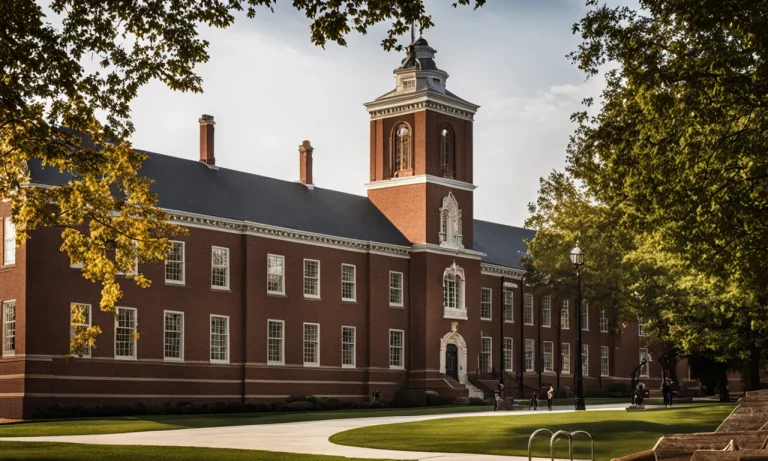Public education has long been a cornerstone of American society. But who exactly runs and manages public schools? Are they part of the government or separate entities?
If you’re short on time, here’s a quick answer to your question: Public schools in the United States are considered government organizations because they are funded and overseen by local, state, and federal government agencies.
In this comprehensive article, we’ll look at the complex governance structure of public education in America and discuss the many ways that public schools are intertwined with government at all levels.
Local Governance of Public Schools
When it comes to the governance of public schools, it is important to understand the role of local government entities. Public schools are indeed considered government organizations as they are funded and operated by local government bodies.
These bodies are responsible for overseeing the functioning and management of public schools within their jurisdiction.
View this post on Instagram
School districts
At the heart of local governance of public schools are school districts. A school district is a geographical area that encompasses a group of schools within a specific community or region. These districts are typically governed by a school board, which consists of elected or appointed officials.
The primary role of a school district is to provide educational services to the students in its jurisdiction. This includes making decisions regarding curriculum, hiring and evaluating teachers, managing budgets, and ensuring compliance with state and federal regulations.
Each school district operates independently, allowing for localized decision-making based on the unique needs of the community it serves.
School boards
School boards play a vital role in the local governance of public schools. Composed of community members, school board members are responsible for making important decisions that impact the education and well-being of students.
They are elected or appointed to represent the interests of the community and serve as a link between the local government and the school district.
School boards are responsible for setting policies, approving budgets, and establishing goals and objectives for the district. They also hire and evaluate the superintendent, who serves as the chief executive officer of the school district.
The decisions made by school boards directly affect the quality of education and the overall functioning of public schools within their jurisdiction.
Local education agencies
Local education agencies (LEAs) are another important component of the local governance of public schools. LEAs are administrative bodies that oversee the operation and administration of public schools within a specific jurisdiction.
They are responsible for implementing policies and regulations set by the state and federal government.
LEAs work closely with school districts and school boards to ensure compliance with educational standards and to provide support and resources to schools. They also facilitate communication between schools, parents, and the broader community.
LEAs are integral in ensuring that public schools are functioning effectively and meeting the educational needs of students.
View this post on Instagram
State Governance of Education
When it comes to public schools, it is important to understand the role of state governance in education. State governments play a significant role in overseeing and regulating public education within their respective jurisdictions.
Let’s take a closer look at how state governance works in the education sector.
State Constitutions
State constitutions serve as the foundation for the governance of public education. They outline the powers and responsibilities of state governments in providing and regulating education.
These constitutions often establish a State Board of Education or a similar governing body responsible for making policies and decisions pertaining to public schools.
For example, in California, the State Constitution empowers the state government to provide a system of free public schools. It also establishes the California State Board of Education, which is responsible for setting educational standards and policies for public schools in the state.
State Education Agencies
State education agencies (SEAs) play a crucial role in implementing and overseeing education policies at the state level. These agencies are responsible for ensuring compliance with state and federal laws, managing funds allocated for education, and providing support and guidance to local school districts.
SEAs are typically headed by a state superintendent of education or a similar position. These officials work closely with the State Board of Education and collaborate with various stakeholders, including teachers, parents, and community members, to improve the quality of education in the state.
State Education Standards
State education standards are guidelines that outline what students should know and be able to do at each grade level. These standards help ensure consistency and quality in education across the state.
While specific standards may vary from state to state, they generally cover core subjects such as English language arts, mathematics, science, and social studies.
State education standards are typically developed by the State Board of Education in consultation with educators, experts, and the public. They provide a framework for curriculum development, instructional practices, and assessments in public schools.
It is important to note that state standards are separate from federal education standards, such as those outlined in the Every Student Succeeds Act (ESSA).
Understanding the role of state governance in public education is essential for ensuring effective and equitable education systems. State constitutions, state education agencies, and state education standards all play a vital role in shaping the education landscape within each state.
Federal Involvement in Public Education
Public schools in the United States are primarily funded and regulated at the state and local level. However, the federal government does play a role in public education through various means, including legislation, funding, and policies.
Federal education legislation
The federal government has enacted several pieces of legislation that impact public education. One of the most significant is the Elementary and Secondary Education Act (ESEA), which was first passed in 1965 and has been reauthorized multiple times, most recently as the Every Student Succeeds Act (ESSA) in 2015.
ESSA provides federal funding and guidelines for schools to ensure that all students have access to a quality education.
Other federal education legislation includes the Individuals with Disabilities Education Act (IDEA), which ensures that students with disabilities receive appropriate educational services, and the No Child Left Behind Act (NCLB), which aimed to improve educational outcomes and accountability.
Federal education funding
The federal government provides funding to public schools through various programs. The largest source of federal education funding is the Title I program, which provides financial assistance to schools with high numbers of students from low-income families.
Other federal funding programs include the Individuals with Disabilities Education Act (IDEA) and the Carl D. Perkins Career and Technical Education Act.
It’s important to note that federal funding typically makes up a small portion of a school’s overall budget, with the majority of funding coming from state and local sources.
Federal education policies
The federal government also sets policies that impact public education. For example, the U.S. Department of Education establishes guidelines and regulations for schools, such as those related to standardized testing, school accountability, and teacher qualifications.
These policies help ensure that schools meet certain standards and provide a quality education to all students.
In addition to legislation, funding, and policies, the federal government also collects and analyzes data on public education through the National Center for Education Statistics (NCES). This data is used to inform decision-making and track trends in education across the country.
View this post on Instagram
Key Similarities Between Public Schools and Government Agencies
Taxpayer funding
One key similarity between public schools and government agencies is that they both rely heavily on taxpayer funding. Public schools are funded through a combination of local, state, and federal taxes.
This funding is used to support various aspects of education, including teacher salaries, classroom materials, and facility maintenance. Similarly, government agencies are funded through taxpayer dollars to carry out their specific functions and provide services to the public.
Oversight by elected officials
Both public schools and government agencies are subject to oversight by elected officials. In the case of public schools, this oversight typically comes from school boards or governing bodies that are elected by the community.
These elected officials are responsible for making decisions regarding curriculum, policies, and budget allocations. Similarly, government agencies are overseen by elected officials who ensure that the agency operates in accordance with the law and serves the best interests of the public.
Public service mission
Another key similarity between public schools and government agencies is their shared mission of serving the public. Public schools have a responsibility to provide quality education to all students within their jurisdiction, regardless of their background or abilities.
Similarly, government agencies are tasked with providing services and resources that benefit the public as a whole. Whether it’s healthcare, transportation, or public safety, government agencies exist to meet the needs of the community.
It’s important to note that while public schools and government agencies share these key similarities, they also have distinct differences in terms of their specific roles and functions. However, their shared reliance on taxpayer funding, oversight by elected officials, and commitment to public service highlight their close connection to government organizations.
Conclusion
In conclusion, while public schools in America operate with some autonomy at the local level, they are inherently intertwined with government at all levels. From their governance structures to their funding sources, public schools are organized under a complex system of governmental oversight and control.
So when considering whether public schools are government organizations, the evidence overwhelmingly points to ‘yes’.






